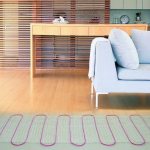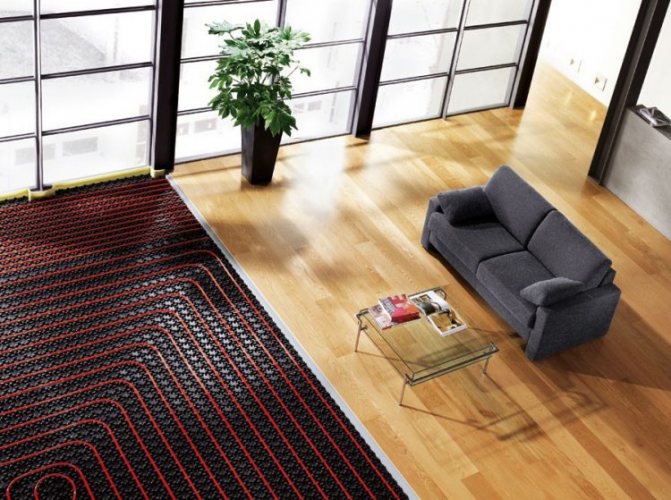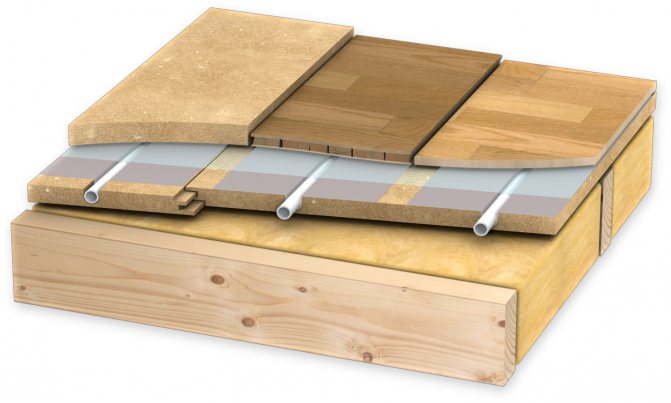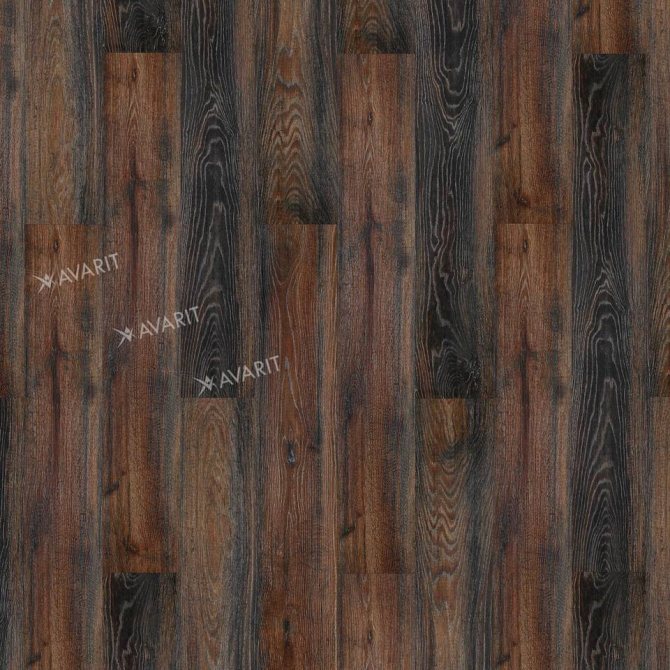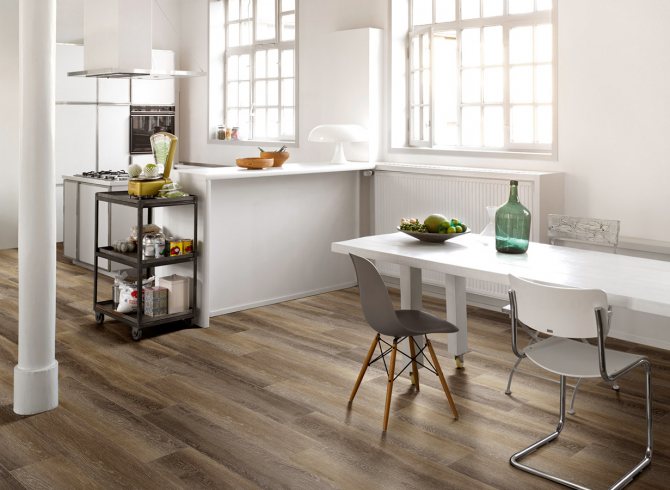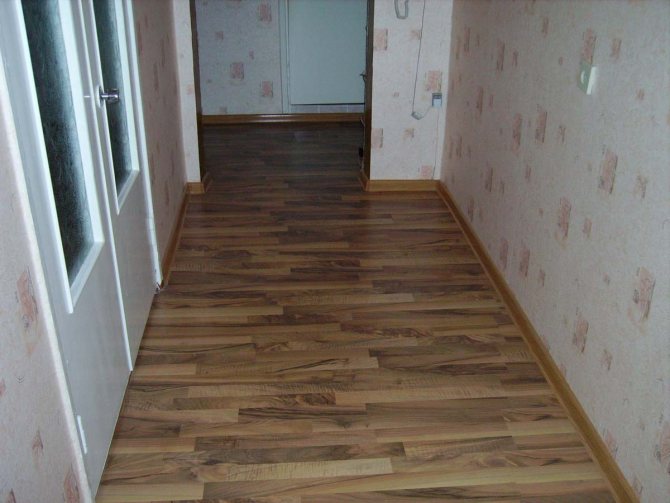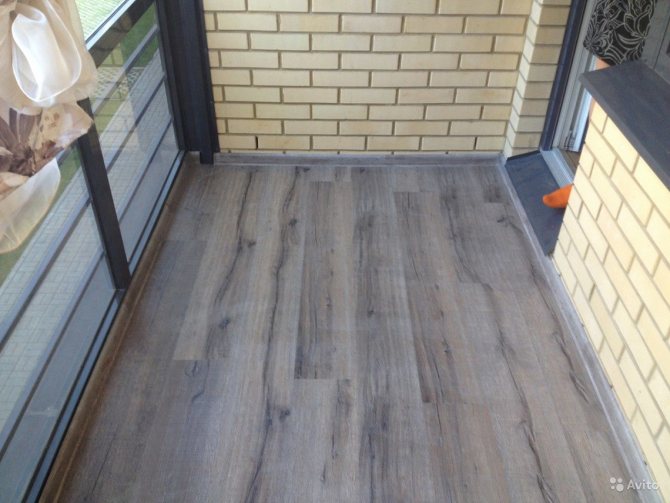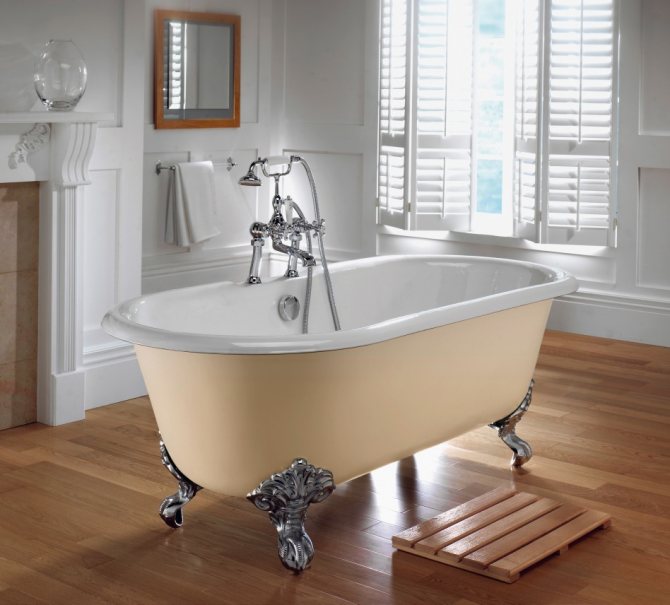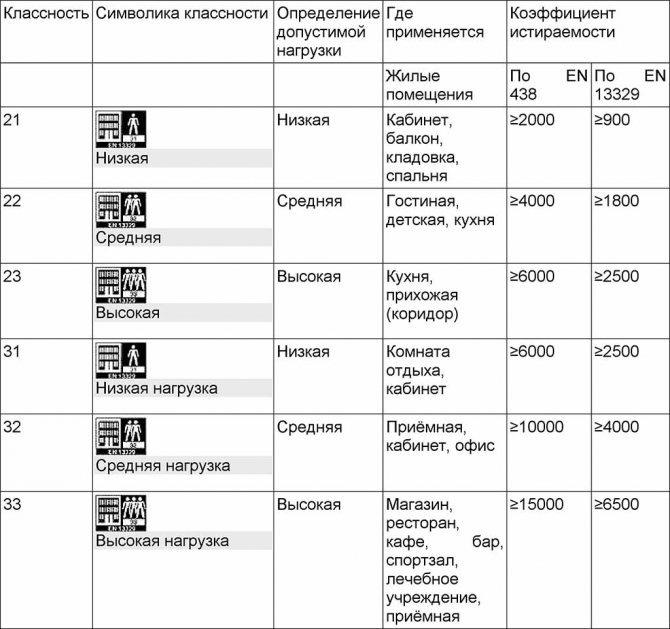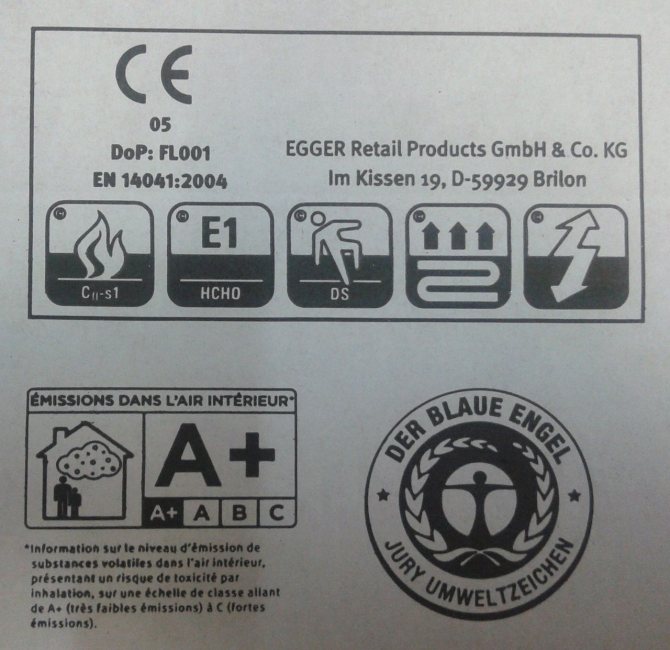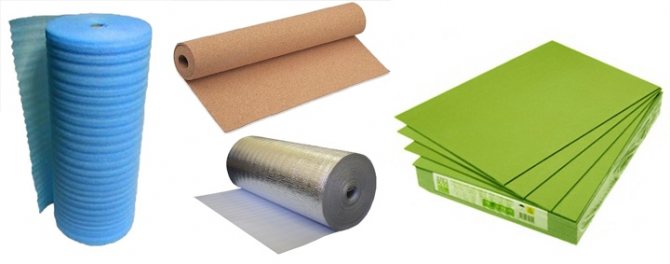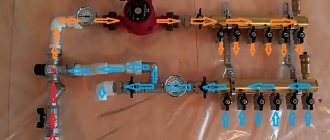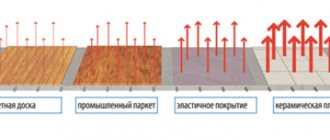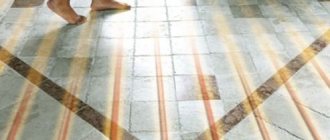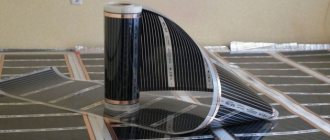Warm floors are considered popular systems among owners of private houses or apartments. They provide high comfort of living, and are presented in certain varieties. The specific type has its own parameters, but the most popular is the water floor, which is economical in use. At the same time, many people are interested in the question, you can use a laminate for a warm water floor and this is correct, because for this work you need to choose a high-quality material that perfectly copes with the effects of high temperatures, and also does not collapse from exposure to moisture.
Coating features
It is possible to create a water system, on top of which the laminate will be laid, on different types of bases. The main question is considered to choose the right floor covering that can easily cope with the effects of high temperatures. Modern manufacturers produce many collections of such laminate, which are distinguished by their excellent appearance, reasonable price and long service life.
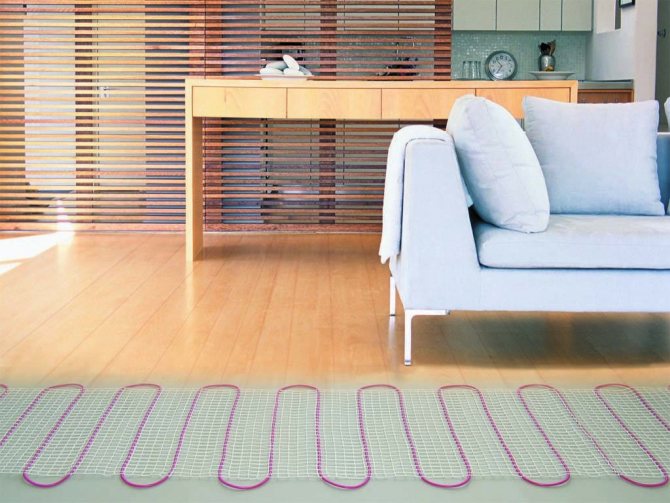
Laminate for a warm water floor, correctly selected in accordance with the existing conditions, has advantages:
- optimal thermal conductivity, which ensures the formation of the desired heat transfer rate, which is approximately at the level of 45 degrees;
- due to the use of high-quality material, even a reduction in thermal energy consumption is guaranteed, and by about 40 percent;
- no magnetic field is formed, which has a negative effect on the human body;
- constant dryness of the coating is ensured, so fungus never appears on it and dampness does not appear;
- modern manufacturers offer a material of high quality and environmental friendliness, therefore it is considered safe for permanent use in residential premises;
- floor heating is provided quickly, which is considered especially relevant for many residents of houses, since it is often important to ensure prompt heating of the premises;
- under the laminate, a water-heated floor lasts a long time, and much longer than when using other floor coverings.
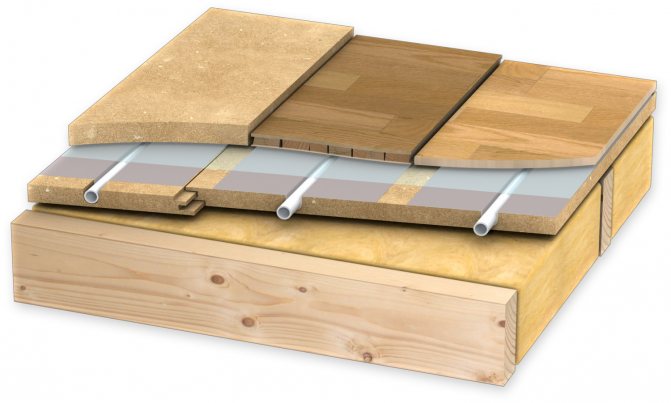

Scheme of a water-heated floor under a laminate
The disadvantages include only the complexity of installation, which is why many people trying to carry out the work on their own make significant mistakes, so the system does not last long or the coating is destroyed.
Experts insist that laying the laminate on a warm water floor should be done only in residential buildings, and in apartments this work is prohibited, and this is due to the norms of the legislation and the need to install powerful pumps and containers for pumping water that take up a lot of space.
Types of laminate for warm water floor
An important point is the purchase of a high-quality and reliable coating with the right parameters. You need to know which laminate to choose so that it can serve over the underfloor heating system without any problems. To do this, it is important to take into account in which room the work is performed, how much money is allocated for these purposes, as well as what markings are on the laminate itself. In this case, all the important nuances of a competent choice are taken into account.
Marking
When choosing a coating, it is important first of all to look at its marking, which is considered the most important parameter. Each package has certain signs that mean certain parameters of the laminate.They are applied directly by the manufacturer, which allows you to make the right choice of laminate, ideal for warm water floors.
Laminate marking
It is advisable to take into account the following markings:
- plus with a degree - means that the coating is really ideal for installing a warm floor. It will easily withstand high temperatures, and at the same time it will not collapse or release harmful components into the room;
- a woman's foot in a shoe with a heel - shows that the laminate has a high compressive strength;
- lightning - it is guaranteed that such a coating will not accumulate static electricity;
- a teapot falling to the floor - a laminate with such a mark can easily withstand even significant mechanical stress, without collapsing from impacts;
- a zigzag pipe located under the covering - indicates the purpose of the covering for laying over warm floors;
- dog - a coating with such markings will not break from the claws of animals;
- flower - indicates that the material is environmentally friendly, therefore, it is completely free of any harmful components.
Laminate packaging designations
Additionally, there are many more different markings, all of which mean one or another coating parameter. Since the material is supposed to be laid on top of a warm floor, its most important property is its resistance to high temperatures. There must be appropriate markings on the packaging. If you buy ordinary laminated material, then there is a high probability that during its operation with the heating system turned on, it will begin to crack and will not last too long. Additionally, due to the low thermal conductivity, the efficiency of the underfloor heating system will be low.
The manufacturer on the packaging additionally indicates for which particular system of underfloor heating a certain material is ideally suited, therefore some panels are designed for a water system, and others for an infrared or electric system.
Thermal insulation properties
This parameter is also considered important for the correct choice of laminate. It is important not only to take into account the marking, but also on the KTS (coefficient of thermal resistance). The higher it is, the better the thermal insulation parameters of the created floor covering.
Since the material is used for underfloor heating, the KTS should not be more than 0.15 m2 K / W.
This indicator is influenced by the following material parameters:
- the thickness should be small;
- the density must be minimal.
If you choose a laminate with a significant thickness and density, then the floor covering and even the substrate can overheat, and there is also the possibility that even the heating circuit itself will quickly break.
Laminate board structure
The choice of class depending on the room
Another important parameter of the laminate for a warm water floor is its class. The higher it is, the more durable and reliable the created coating will be. However, it is important to take into account that since the material will be constantly exposed to heat, it is optimal to choose class 32 for these purposes.
Also, when choosing a laminate, it is important to consider in which room it will be laid. The best option is chosen for each room. Usually, the most important zones are highlighted in any house.
Types of household laminate
As for the kitchen, here usually people are not only engaged in the process of cooking, but also accept it. Therefore, there is usually more than one person in one room. They constantly move, and also use various objects with a high weight, so the important point is the resistance of the coating to strong impacts, as well as the ease of cleaning from all kinds of dirt and stains.
It is advisable to choose a moisture-resistant laminate for this room, and after laying it, it is recommended to treat all floors with a special water-repellent solution. It is important to lay it only with the use of a special sealant, with which all joints in the coating are processed.
For a kitchen, the optimal laminate class is 32 or 33. In addition, it is important that the material has an optimal thermal conductivity. Kitchen
Bedroom and corridor - for these rooms it is advisable to use a laminate with a matte surface.
In addition, since the installation is carried out on a warm floor, moisture resistance and resistance to high temperatures are important parameters for such a coating. Good sound insulation and antistatic properties are important. For the bedroom, it is allowed to choose class 21 or 22, since people rarely go here, but for the corridor it is best to buy class 33, since they most often go here, and it is in shoes, therefore, it is important that the coating is durable and wear-resistant. Bedroom Hallway
Bathroom and balcony - here the most optimal use of water heating under the floor, since this provides the comfort of water procedures or relaxation on the balcony. However, maintaining the temperature not exceeding 30 degrees is considered an important point. For this, in the process of creating a warm floor, thermostats and sensors are certainly used. This will eliminate the likelihood of overheating of the laminate flooring, which can cause its deformation. The joints here are treated with a sealant, and also the top of the entire coating is covered with a special moisture-repellent agent.
Bathroom Balcony
Thus, it is important to choose the best option for each room in the house. Some people prefer to do a continuous installation, according to which the same material is used in each room, in which case it is important to purchase the highest quality and most reliable laminate that is suitable for each room.
Connection type
When choosing a floor material, it is recommended to additionally pay attention to the type of connection of individual panels in the covering. There are the following popular and demanded types:
- click - these connections are usually used on long board edges. Locking of the locks is performed by turning the inserted board into another board;
- lock - most often found on end edges. Locking the boards is performed by driving one element into another, and it is also allowed to overlap them, but in this case it is important to use additional glue. There are spikes and grooves on each panel, and everyone who does not have experience in this area can work with them. Therefore, the preference is most often given to this particular laminate, since property owners have the opportunity to carry out finishing work on their own;
- uniClick - locks can be found on the end or long edges of individual panels. Fastening can be done both by hammering and by turning.
Laminate connection
When choosing a laminate, the method of connecting the individual panels to each other is quite important. In this case, not only the locks, which the lamellas are equipped with during the production process, can be used, but also a special adhesive composition. However, an adhesive bond is not suitable for a coating located above a water-heated floor. This is due to the fact that when heated, the glue can disperse, therefore, the resulting floor will deform.
Experts recommend the Click system for underfloor heating, since such panels are highly durable and reliable, and also do not deform under the influence of high temperature or when it changes abruptly.
Suitable substrate
Another important parameter for creating the perfect coverage over a warm floor is the use of a correct and high-quality underlay.It should only fit on a perfectly flat base, therefore, the alignment procedure is preliminarily carried out.
Next, the substrate is spread, and it is necessary to level out the small differences that remain after the formation of a new screed. It also increases the soundproofing parameters of the floor and acts as an additional heat-insulating layer.
Most often, for a laminate laid on a warm floor, a substrate made of extruded polystyrene foam or cork is chosen, and isoplates are also suitable. As a rule, the underlay is laid with adhesive tape so that no gaps remain between the boards or rolls.
Types of substrates
Laminate for water floor heating
The answer to the question of which laminate to choose for a warm water floor is only one - the most reliable. The material must be of high quality, with high density and always with a protective coating. If the laminate meets these requirements, then with a high probability it will be able to transfer the "neighborhood" with the water floor.
Water-based heating has some points: humidity combined with a sufficiently high temperature. Conventional laminate tiles will not be able to withstand such conditions for a long time, but high-quality ones will be able to maintain an attractive appearance and good performance for a long time.
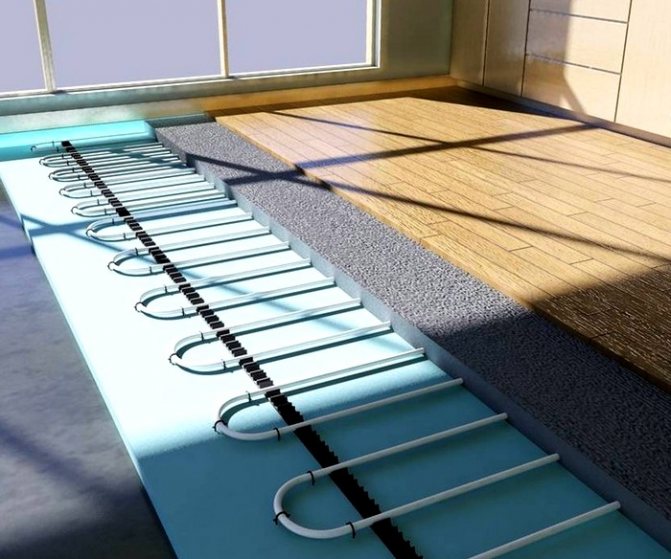

Water-based heating has some points: humidity combined with a sufficiently high temperature
When choosing which laminate is better suited for warm water floors, you should pay attention to the following characteristics:
- high wear resistance (class 33 and above);
- moisture resistance;
- thickness of at least 8 mm (otherwise the laminate will quickly lose its shape);
- marking.
On the packaging of laminate for warm water floors, the H2O marking is always indicated
On the packaging of laminate for warm water floors, the H2O marking is always indicated. Instead, there may be an inscription - "Warm Wasser" or "Underfloorheating". You need to choose exactly these and use it for the intended purpose (i.e., do not lay on infrared or electric).
Attention! When using a warm floor, it is important to observe the temperature regime.
Ideally, the temperature should be around 27 ° C. It is undesirable to heat the panels above 30 ° C, as they can deform and lose their appearance. An increase in temperature is also dangerous because strong heating will lead to the release of formaldehyde, which will adversely affect the well-being of people.
You can regulate the temperature using a special device for temperature differences. This device displays the temperature difference between laminate and floor. It is necessary to change the specified value smoothly, since a sharp heating increases the likelihood of deformation of the laminate.
Laminate laying technology
After all the preparatory work, the choice of material and the installation of the substrate, the direct laying of the laminate on the warm floor begins. The whole process is considered standard, but it is important to consider the following nuances of work:
- initially, it is important to make sure that the created system of underfloor heating is functional, and there are no problems when using it;
- it is recommended to warm up the base before laying the material;
- joints are certainly processed with a sealant;
- a small gap of about 8 mm is left between the coating and the walls;
- the panels are connected to each other with the corresponding locking elements, which they are equipped with during the production process.
Parallel laying Spiral laying Screed Laying laminate
Thus, if you plan to create a water-heated floor, on top of which a laminate covering will be formed, it is important to choose the material itself correctly, and it must be reliable and of high quality, and also specially designed for operation in such conditions when it is constantly exposed to high temperatures. and there is also the possibility of a sharp change in temperature. In this case, you will get a durable and reliable coating, which will always be comfortable to walk on. At the same time, the choice and the installation itself can be done on their own, so you do not have to spend money on paying specialists.If all the nuances of the work are taken into account, then laying a water-heated floor under the laminate, you get a high-quality result.
Source: www.climatechange.ru
Which warm floor is better for laminate: infrared or water
Every year, laminate manufacturers are releasing more and more new types, including special ones, used for heated floors. They have full compatibility in technical characteristics, so the use of such a laminate is absolutely safe.
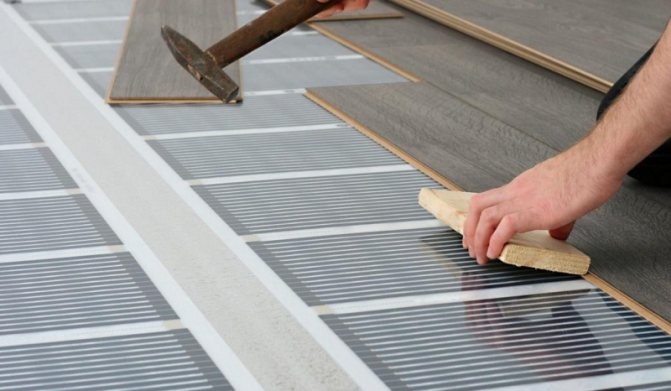

Infrared floor heating goes well with almost any laminate
There are two popular types of underfloor heating:
- Infrared;
- Water.
The infrared floor has a low heating temperature, but it evenly heats the air in the room. Almost any laminate can be placed on it, but the factory marking should indicate that this is allowed by the technical specifications.
The water floor can be heated to high temperatures, so you need to choose a laminate with a limit of 29 ° C. The factory marking should indicate that this type of coating is intended specifically for water-heated floors.
Both options are very popular, so the choice of flooring will depend only on the manufacturer's recommendations.
If the floor covering does not have the appropriate marking, then laying it on a warm floor is strictly prohibited, since it can emit formaldehydes when heated, which are harmful to the human body.
Selection criteria for cladding
Installation of water or electric heating systems for the further laying of a conventional laminate can result in a host of problems associated with the constant heating of the material to 25-27 ° C.
When laminate sheets are heated to temperatures above 25 ° C, harmful formaldehydes are released, which are used in the composition of resins and binders involved in the manufacture.
The use of conventional laminate up to 25 ° C absolutely does not cause any harm to human health and others, which has been confirmed by a number of studies. Specialized laminate for underfloor heating is devoid of this drawback due to the use of a special manufacturing technology based on reducing the amount of harmful binders.
The accessory and the possibility of installing the laminate over the installed underfloor heating system is indicated on the packaging and in the installation instructions that are attached to the material. For most manufacturers, this is evidenced by a special marking in the form of a stylized icon indicating underfloor heating, spiral heating elements or an accompanying comment like “Underfloor Heating”.
Next to the marking, the recommended type of heating systems and the temperature range in which it is allowed to use this material are indicated, without any problems.
From a technical point of view, a laminate for underfloor heating must have a certain coefficient of thermal conductivity. According to European standards, the thermal conductivity index for the finishing cladding laid over the heating system should be no more than 0.15 m² * K / W.
The 0.15 m² * K / W value includes the resistance of the laminate used and the substrate used to install it. For example, a coating was purchased with a coefficient of 0.078 m² * K / W and a substrate with an indicator of 0.066 m² * K / W. In total, this gives 0.144 m² * K / W, which is quite consistent with the requirements.
The choice of materials with appropriate thermal conductivity should be approached with complete seriousness, since the further operation of the coating depends on this. If the stated standards are exceeded, there is a risk of overheating of the underfloor heating system and damage to the floor cladding.
Load class
The class of the laminate speaks of the ability to withstand wear and tear. The material can have classes 21-23 and 31-33.Manufacturers advise using the material with the first three classes for the home, with the other three for commercial premises. Of course, for home owners it will be better if laminate boards of 31-33 classes are laid.


Load classes
Nuance - the higher the class, the greater the density of the material, and the less heat it passes through. Given this feature, each owner must decide for himself what is more important - savings on heating or a long "life" of the floor.
Laminate of a certain class is selected depending on what the living area of the house is. The kitchen, for example, is a place where the whole family often gathers, and where factors that can damage the surface of the coating constantly appear. Here, the best is laying the cover of 32-33 classes. To increase the efficiency of heating, pipes should be filled with sand-cement mortar. To protect the material from water, the joints are filled with sealant.
For a bathroom, 23, 31 classes are suitable. Here you need to use "aqua-laminate" and a regulation sensor, which will provide smooth heating and will not allow the main element to heat up to a temperature of more than 29 degrees Celsius. This sensor should be used in any room.
Building materials of class 21 are used for the bedroom. Here, it is appropriate to lay material with a matte surface (it has a sound-absorbing and antistatic effect). Material with such a surface is also installed in the hallway, children's room. For these rooms, it is preferable to install laminate of 31-33 classes.
Coverage class and type of room
The class of the laminate directly affects its quality - the ability to withstand mechanical stress, abrasion resistance, durability, etc.
When used in conjunction with additional heating systems, the material is constantly subjected to thermal expansion, which affects its service life not for the better. Based on this, almost all specialized coatings with a resolution marker have 32 and 33 product class.
Of much greater importance is the choice of coverage appropriate for the type of room. That is, it is completely irrational to use especially durable types of material in places where the time for heating the floor above 25 ° C is rarely exceeded 2-3 hours per week, and the degree of traffic intensity is minimal.
So, when laying laminate for warm water and electric floors in various rooms, the following points can be taken into account:
- kitchen is a place with high traffic intensity and traffic. With a high probability of spilling liquid and debris on the floor. A place where it is possible to simultaneously find several people and a pair of pets. It is recommended to install water systems with 33 strength class cladding and water-repellent properties;
- bathrooms - rooms with average traffic and average traffic. Permanent exposure to moisture and abrasive particles is possible. It is desirable to install water-heated floors with a 32-class coating with water-repellent qualities;
- living room - a place of frequent or permanent stay of one or two people. Debris and abrasive particles may enter. It is possible to lay both water and electric heating structures. It is desirable to lay a 32 class laminate with fire protection, anti-static and sound-absorbing qualities;
- nursery - a room where the laying of safe material is required. It is desirable to use materials of class 32 with a matte surface and the presence of anti-slip and antistatic qualities, fire protection and a protective water-repellent layer.
When installing the floor in storerooms or other technical rooms, you can use simpler coatings of 31-32 class. Lower quality laminate can be installed if necessary, but the lifespan of such a coating is very short.
Premises, laminate and its class
Builders divide the premises in which the flooring will be laid into zones. The more visited the area, the higher the class of the laminate should be.
The indicator indicates susceptibility to abrasion and quality, including of locks. Placed above a warm floor, the laminate is subjected to increased stress, which equates its existence to work in extreme conditions. High wear resistance is defined by a class of at least 32.
When buying a laminate, you must also follow the manufacturer's recommendations regarding the area in which the product can be used.
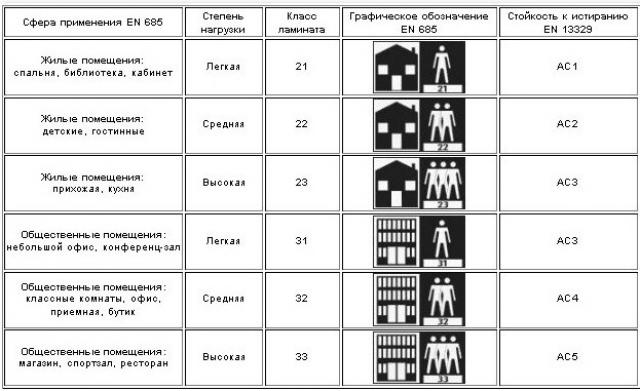

In those residential areas where there will be no large traffic of people (bedroom, office, library), it is possible to lay laminate, the class of which is from 20 to 30, even above the warm floor. And where there is constant movement, you need a product with a class of at least 32.
And now a little about how to select slats for each individual room.
Kitchens. Zone no. 1
Even if the whole family is working and studying, it cannot do without a kitchen. The processes of food preparation and its further use are fraught with moisture, fat falling on the floor, and sharp objects falling are also inevitable. This means that the kitchen only needs a laminate with a moisture-resistant marking and one that is covered with a special wax composition. The product class is not lower than 32. At the same time, do not forget about the labeling for a warm, say, water floor.
It is important! If you like a laminate with such characteristics, you need to carefully examine the locks and it is advisable to try to apply some effort at the junction of the two plates in the store.
When laying, in order to extend the life of the new floor, it is worth treating the joints between the elements with a colorless sealant. This minimizes the possibility of moisture getting under the floor covering.
Bathrooms. Zone 2
A quality aqua bathroom laminate can compete with ceramic tiles. Moreover, even without heating, it will be much more pleasant to the touch. In order for the use of laminate flooring in the bathroom to be effective, it is necessary to strictly adhere to the rule that the temperature of the heating elements under the laminate should not exceed 26-28 0C.
You can correct the temperature using a special sensor, the task of which is to take readings between the laminate and the floor itself. By gently heating all elements, heat drops can be avoided. And accordingly, minimize the risk of deformation of the floor dies.
For children, bedrooms, hallways. Zone no. 3
A matte surface, antistatic effect, high moisture resistance, fire protection and good sound absorption are the main characteristics that a laminate flooring for children's rooms and bedrooms should have. It is quite enough for such zones to buy a product of the 21-22 class. The color for the floor in these rooms can be chosen close to natural wood.
A sufficiently effective, safe and simple heating structure for such a floor - ready-made mats with a cable or a warm film floor. This installation option does not imply the presence of an additional screed, since the heating elements can be laid directly on the floor. As a result, you get a room with a good microclimate, comfortable temperature and no drafts on the floor.
Glue or lock type of lamella connection
The type of connection of laminate lamellas can be as follows:
- Glue - it is carried out according to the standard “thorn-groove” scheme with the obligatory processing of the “thorn” with an adhesive composition. For styling, use improvised means in the form of a hammer or mallet. During dismantling, the lamellae may break or the fasteners may be scrapped.
- Zamkovy - does not require the use of binders and adhesives. It represents a system of locking connection, when on one side there is a recess of a certain shape, into which a “spike” of a suitable design is placed.
For laying over the underfloor heating, it is allowed to use a coating only with a lock type of connection, since the adhesive composition heats up and rather strongly fixes the facing lamellas.
The lock connection, in turn, is divided into several types, but the most popular are the "Click" or "Lock" systems. The first is a snap-on lock that provides a more secure connection, even when mounted on a relatively uneven base.
Second, it is a more common fixation by means of a lock similar to a standard “tongue-and-groove”. This type is very demanding on the quality of the base, since even with slight differences in height, there is a risk of fracture at the junction of the lamellas.
The use of material with the "Click" system is preferable due to its resistance to possible swelling, thermal expansion, etc.
Criteria for selecting a suitable substrate
The selection of the substrate is carried out taking into account the used floor covering and its thermal conductivity coefficient.
It is important to take this indicator into account, since the use of non-specialized substrates of various thicknesses can lead to overheating of the heating system and uncontrolled energy consumption.
The specialty substrate is made of extruded polystyrene or expanded polyethylene foam. The standard thickness is 1.5-3 mm, the thermal conductivity coefficient is 0.04-0.08 m² * K / W.
For example, a substrate of the Arbiton company under the IZO-FLOOR THERMO brand is made of extruded polystyrene, has a thickness of 1.6 mm and a resistance of no more than 0.06 m2 * K / W. The Quick-Step Uniclic Plus backing is made of foamed polyethylene, has a thickness of 2.1 mm and a thermal conductivity of 0.059 m² * K / W.
In practice, the polyethylene substrate lends itself well to cutting, it is easy to fit and join. The polystyrene coating is distinguished by high heat and waterproofing properties, which makes it possible to lay it together with a water-heated floor.
In addition to the above materials, a natural cork backing can be used for installing a laminate for a warm floor. This material meets all the requirements - thermal conductivity 0.042 m² * K / W at a thickness of 2 mm.
Cork is an environmentally friendly material, does not rot, does not contribute to the vital activity of fungi and parasites. It is a direct alternative to coatings made from synthetic products. The only negative is the price, which, together with the laminate, can exceed 1000-1300 rubles / m2.
Experiment # 3
The coolant temperature in the circuit is 42 degrees. The characters are the same, but a substrate is mounted under the laminate (extruded polystyrene foam 3 mm thick)


You shouldn't even show on the graph the moment when I installed the underlay under the laminate. Everything is perfectly visible and so. Expanded polystyrene is an excellent heat insulator. He did not disappoint, and even 3 mm was enough to reduce the surface temperature of the laminate by 1 degree at once. As a result, even at a coolant temperature of 42 degrees on the surface, only a little over 30, and the difference between the temperature of the screed and the laminate reached 3.5 degrees! And again the laminate has become cool to the touch ... It's time to try expanded polyethylene foam. The thickness is also 3 mm.
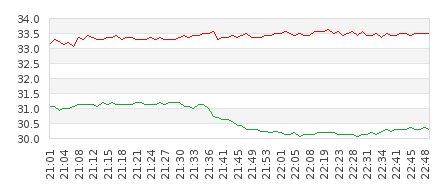

Now can you find the point on the graph when the background was replaced? With difficulty ... Indeed, contrary to my expectations, the difference between expanded polystyrene and expanded polyethylene was only 0.1-0.2 degrees, which can even be attributed to the measurement error. In terms of thermal conductivity, polystyrene foam roughly corresponds to polyethylene foam. There is practically no difference in what material is used for the substrate. Only the thickness is important! Actually, SNIPs tell us the same as the calculations. Not even interesting.Considering the results, it can be stated that 3 mm is a lot. It is better to take a 2 mm thick substrate. There will be less losses.
How can we return the warmth to our feet again? Everything is as usual - turn up the heat. So we are setting up a new experiment.
Material tips for different types of systems
Using wood cladding on top of a warm water floor sets aside a number of limitations on the floor to be used. This is largely due to high humidity and the possibility of direct contact with moisture.
When choosing a laminate for a floor with water heating, the following nuances should be considered:
- marking - the presence of a specialized stylized badge or marking "H20" indicating the possibility of using in conjunction with water heating systems. These coatings are highly dense and water-repellent;
- class - it is preferable to use class 32-33 with a lock type of connection. The type of connection is “Click”, since in the case of using “Lock” locks and swelling of the laminate, damage to its fixing elements is possible;
- safety - it is possible to use only safe coatings marked “E1” or “E0”, indicating the amount of formaldehyde substances included in the composition.
When laying on a water-heated floor, the use of especially thick types of coating is not recommended. This greatly affects the thermal conductivity of the system and indicates a low density of the material used.
The purchase of a laminate for a warm floor is carried out in a similar way. The first step is to check for the presence of special permissive marking, compliance with the class and the presence of a coating that prevents fire.
Otherwise, the choice of material, both for water and electric heating systems, is carried out taking into account the type of room and the requirements for the cladding.
Source: otdelkaexp.ru
Varieties of warm substrates
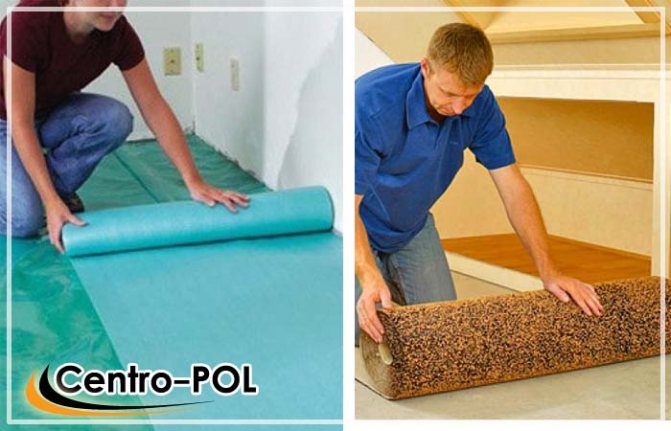

Example of chipboard and mineral backing for laminate flooring
Insulation for laminate is chosen based on its technical parameters and properties, as well as future conditions of use. Of course, it is best to use several types of building materials at once, which will be used at various stages of floor insulation. For example, for a concrete base, the best option would be to lay granular clay and mineral wool.
Distinguish between mineral, wood-shaving and polymer warm substrates, which significantly reduce the thermal conductivity of the laminate. Each of the types has its own specific operating conditions, which should be taken into account before installation.
Chipboards are generally used for dry screeds. Many of them are afraid of moisture, so some types are not recommended for laying in rooms with high levels of humidity. Wood-based insulation includes:
Cork laminate: types, characteristics, laying technology and care
- plywood treated with moisture resistant substances;
- chipboard;
- cellulose filler;
- fibreboard
Mineral or natural substrates are produced only from environmentally friendly components. Warm laminate with natural flooring can even be used in children's rooms, as it is hypoallergenic. Mineral insulation includes:
- fiberglass, slag and stone wool;
- granulated clay (expanded clay);
- dry cement compositions with additives;
- foam glass.


Warm underlay on concrete base
A warm underlay for a laminate made of polymeric materials is laid on concrete bases. This is because synthetic flooring can give off a very corrosive gas when ignited. That is why they decided to use them in construction only in those conditions where contact with electrical wiring and fire is impossible. Polymeric thermal insulators include:
- polystyrene foam;
- foamed liquid heaters;
- thermal insulating paints;
- polyurethane;
- extruded polystyrene foam.
Characteristics of heat insulators
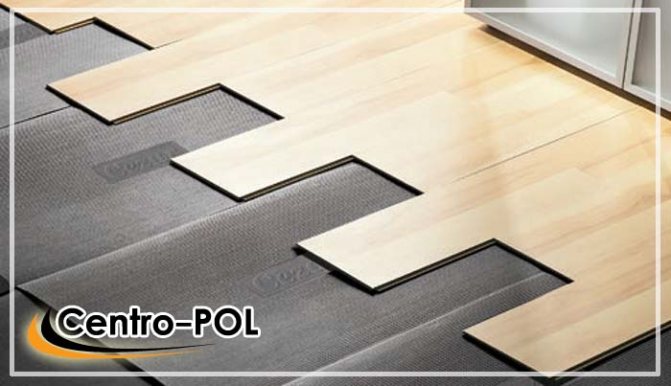

Rubberized backing for noise absorption
Which laminate is warm largely depends on the type of buffer material that is placed between the subfloor and the lamellas. A high-quality backing layer must have good technical characteristics, only then will it perform its functions efficiently:
- Water vapor permeability. Self-ventilation is very important, especially in rooms with high humidity. "Breathable" materials do not collect condensation, thereby protecting the flooring from destruction;
- Soundproofing laminate flooring. Since laminate flooring is made from unnatural materials, loud noise is generated when walking on the surface. This problem must also be dealt with by a heater that can absorb impact sounds;
- Coefficient of thermal conductivity. This indicator determines the ability of the substrate to transmit heat;
- Biostability. Some types of buffer decks are a favorable environment for the development of pathogenic flora. To a greater extent, this applies to wood-based substrates. Be sure to take this factor into account when installing the litter in a room with a high level of humidity;
- Porosity. Influences such characteristics of insulation as microcirculation, thermal conductivity and heat capacity;
- Water absorption. Insulated laminate with a substrate that has a low water absorption rate can be used in conditions of high humidity.
Polystyrene backing
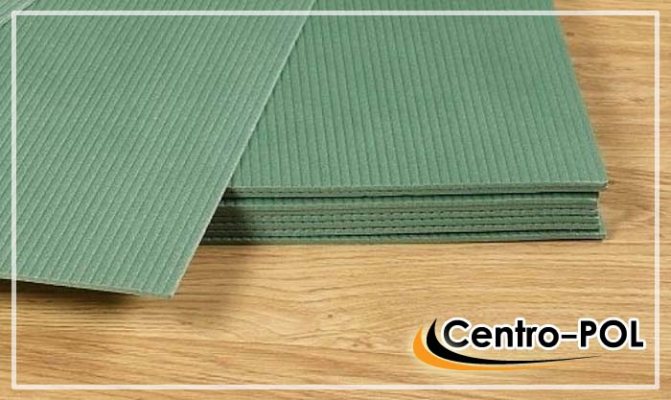

Expanded polystyrene is resistant to chemicals
Extruded polystyrene foam under the laminate is able not only to retain heat in the room, but also to provide good sound insulation of the floor covering. Unlike other types of insulation, this one has a number of very important advantages, thanks to which "foam" is in demand among many consumers.
Choosing oak parquet: technical characteristics and features
For your information: Expanded polystyrene is resistant to the influence of chemicals, which makes it an almost universal heat insulator.
In addition, it has the following advantages:
- practically does not deform with prolonged use;
- able to withstand significant loads on the coating;
- resistant to fire, so high temperatures are not terrible for him;
- demonstrates a good performance in compression, which indicates its ability to elastic deformation;
- not prone to rapid biodegradation;
- fits without any additional fasteners or glue;
- has a low coefficient of water absorption.
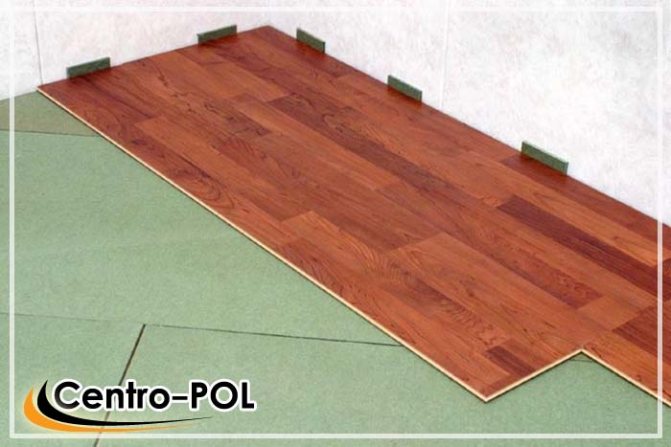

Expanded polystyrene is a fairly soft material
The extruded substrate for the laminate is available both in the form of a roll and in modules, which are especially convenient for laying in small rooms. Modular heaters often have a locking system similar to that of lamellas - “thorn-groove”. Thanks to such a flooring device, it can be laid very quickly in a room with any area.
It is worth considering: Expanded polystyrene is a rather soft material that does not allow it to level even minor irregularities on the base. Therefore, before installing a monolithic insulation from the modules, it is imperative to level the rough covering.
According to experts, this material is capable of absorbing up to 20 decibels, which can eliminate up to 50% of all noise. This feature of polymer flooring eliminates unpleasant impact noises and squeaks when walking on the floor surface.
We carefully read the marking
The limitation on the installation of a laminate on a warm water or film floor lies in the method of production of this flooring. Fiberboard used to be the stabilizing base of laminate boards. In the process of its manufacture, synthetic resins were used to bond the fibers.When heated from a warm floor, they could emit toxic substances, which was a problem for installation on a warm water floor. Everything changed with the arrival of MDF and HDF boards. By their structure, these are fiberboards. The second type has a higher density than the first. Thanks to this, it was possible to reduce its thickness, and therefore to increase the heat-conducting properties. By themselves, these boards are environmentally friendly if the manufacturer honestly adheres to the technology. The binding of fibers occurs due to a substance that is part of the wood itself. Natural resins are added. Further problems lay in other components of the laminate.
The face layer is responsible for the wear resistance of the entire material. Therefore, it must be made quite durable. This can be easily achieved using various polymer compounds. It can be acrylic or melamine composite resin. The constant influence of the elevated temperature of the warm floor on them did not bring much benefit. Additional pitfalls were layers of paper that could be soaked in paraffin or other chemicals to provide additional moisture protection.
Each package with laminate boards has a large number of different designations. One of them has the preceding Latin letter E. It refers to the level of emission or release of various chemicals. For a cold floor, this figure can be 2 or 3. But if you plan to cover a warm water floor with laminate, then there should be 1 or better 0. This means that the emission level is the lowest, which does not harm health or is practically absent.
Additional identification marks that will tell you about the correct choice for a warm floor will be a temperature icon indicating specific values. They can range up to 30 ° Celsius. Typically, a laminate for a water-heated floor has a schematic mark of a curved pipe with a water icon or its chemical formula. Other pictograms, such as the heel of a lady's shoe, a thrashing kettle, or animal paws, indicate resistance to abrasion and other physical influences. A zigzag of lightning will inform that the laminate does not accumulate static electricity, which means it is safe for sensitive equipment and electronics.
How well it gives off heat
If we take into account ceramic or porcelain stoneware tiles, then in relation to them there are no questions about the thermal conductivity from the warm floor. It has a high value, which is good for a warm floor. This becomes apparent even with simple daily use. If you stand on a cold tile, then the sensations will not be the most pleasant. This is due to the fact that the area of contact with the surface of the foot is significant, and the density of the material itself is quite high. This means that he is able to quickly pick up heat and give it to the screed, which is located below. This is not the case with laminate flooring. If you tried to walk on it barefoot, then such unpleasant sensations did not arise. This suggests that its thermal conductivity is lower, which means that it will give worse temperature from the water heated floor to the air.
It is also important to pay attention to the markings in order not to get into a mess. The value of the thermal conductivity coefficient is indicated by a number, followed by W / m × K. According to European standards, for a floor covering that is laid on a warm floor, this figure should not be more than 0.15. But a laminate with such a value is also not worth taking. You need to look for the value below. This must be done, since it is necessary to take this coefficient from the substrate. Together with the laminate, the figure should not exceed 0.15 W / m × K in value. You can find out by putting them together.For example, 0.8 W / m × K will be written on the laminate, and 0.6 W / m × K on the substrate, the total will be 0.14 W / m × K, which is quite acceptable for a warm floor.
Determine the thermal conductivity of the laminate when buying
When choosing a floor covering for the "warm floor" system, you need to pay special attention to its thermal conductivity. The higher the coefficient, the higher the thermal insulation properties of the laminate. Typically, the marking is on the packaging with the material. If it cannot be found, then it is necessary to demand the accompanying documentation and certificates from the seller.
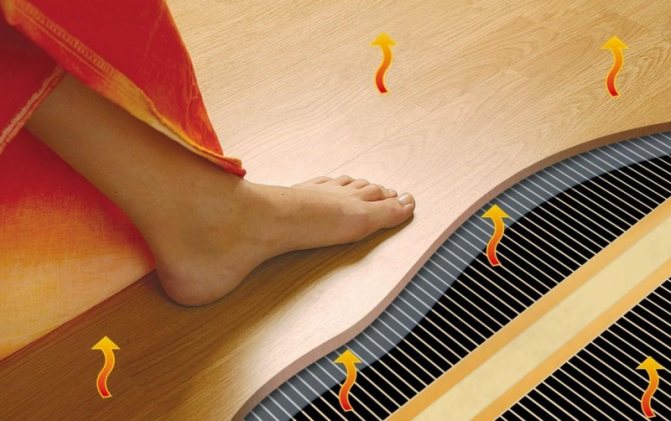

You can find out the thermal conductivity of a particular laminate from the seller or on the Internet on the manufacturer's official website
It should be remembered that the thermal conductivity should not exceed 0.15 m2 x K / W. In this case, it is necessary to add the coefficient of thermal conductivity of the substrate used under the laminate.
Factors to consider when choosing a material;
- Thickness. Laminate boards should be thinner to avoid overheating.
- Density. The lower the density, the better, because the laminate will better conduct heat.
Why laminate
In principle, this is a matter of everyone's choice. But the laminate does have some properties that have not yet been replicated, for example, tiles. Among them are:
- a unique structure that repeats the surface of a tree;
- a variety of prints with patterns;
- a special way of styling;
- ease of combination with the interior;
- ease of cleaning and cleaning;
- resistance to physical influences;
- resistance to UV rays;
- resistance of some types of laminate to moisture;
- the possibility of laying by the deck method, observing a single contour;
- long service life;
- high environmental friendliness.
And now, laying together with a water-heated floor makes this material ideal. The disadvantages include the high price for elite models. It also requires special scrupulousness during installation on a warm floor, so some inexperienced craftsmen may not be able to cope with the task.
Each room has its own class
You may have noticed that the greatest floor scuffs are observed at the doorstep, in the dining room and in the kitchen. It is in these rooms that people are most often, which leads to deterioration of the coating. The same situation will occur with laminate flooring. If you are planning to install laminate flooring in all areas, then it is worth considering choosing its strength. Manufacturers distinguish several strength classes for the laminate. If we are talking about laying laminate in an office or corridor of any institution, then you should look towards the 33rd or 34th. It will carry the highest load with the stated service life.
For domestic needs, the twentieth grade is usually chosen, but if it is planned to have a warm floor, then you will have to pay more for the 31st or 32nd grades. It is these subspecies that are allowed for installation on a water-heated floor. In the case when, according to the plan, the laminate should be in the bathroom and in the kitchen, on a warm floor, then make sure that it is with additional moisture protection. This can be expressed in the fact that the stabilization layer will be made of various types of plastics that are insensitive to water. It is important to observe this nuance so that the laminate does not swell and the seams do not come apart, which would lead to expenses for repairs.
Features of laying laminate on a warm floor
Some features of laying on a warm floor dictate the characteristics of the laminate itself. Let's try to highlight the main ones:
- Using a thinner screed than under the tiles will provide better floor heating.
- Since the underlay for the laminate remains necessary for a more convenient installation and for sound insulation, you should not refuse it. In the normal operation of the floor, it serves as a heat insulator, and these properties can be reduced by choosing a substrate with a minimum layer of 3 mm or a special one for underfloor heating with maximum thermal conductivity.
- After the screed is completely dry, let it cool down before installing the laminate. The laminate itself must be in the same room where the installation will be carried out for at least three days (where the floors have already cooled down). Its adaptation to temperature conditions should be gradual, this reduces the risk of deformation from linear expansion.
- Laminate "does not like" temperature changes. Its heating and cooling should be carried out gradually over several days. This applies to the seasons when the heating is switched on and off, when the system is started after the floor has been installed. For this reason, you should not use laminate flooring as a finishing flooring in a country house for seasonal living, where it is not always possible to fulfill similar conditions for warming up a house with a warm floor or gradual shutdown.
A wooden country house needs high-quality insulation with ecowool, only this will allow you to quickly warm it up, arriving on weekends in winter or in the off-season. You can find out about the services of insulation with ecowool on the pages of our website or through the Contacts section by contacting a specialist.
Laying type
The user may also be faced with the question of which method of fixing laminate boards for a warm floor to choose. Until now, a couple of basic tool joint processing techniques have been used. One of them is called Click. Thanks to him, the connection of adjacent laminate planks occurs in a few touches without much difficulty. It is enough to bring one laminate plank to another at an angle of 45 °, insert it into the groove and lower it to the characteristic click, thanks to which the lock got its name. No further action is required.
Another method requires the use of an adhesive backing. This is due to the design features of the Lock. If you look at it in section, it becomes clear that this is an ordinary spike that goes into the groove. At the slightest deformation or displacement, the spike of the laminate can slip out and a gap is formed. To prevent this from happening, a special glue is used for the laminate, which tightly holds the components together. The advantage of using this method is to reduce the gaps between the laminate planks. But the main disadvantage is the impossibility of repairing a separate section, since it is necessary to destroy the locking joints of the laminate. This method of fixing the laminate cannot be used for warm floors. When heated, a significant expansion occurs, and such a laying of the laminate will not be able to play to the required size. Also, in the process, harmful substances will be released from the glue.
Laying technology
When performing repairs and installing water heating, someone prefers that the warm floor is laid in a wet way, and someone wants the water heated floor to be without a screed. Which one is really better, everyone decides for himself. But to put it simply, laying a warm floor with a wet method implies a monolithic pouring of the pipe contour into a screed. This will not affect the laminate in any way, but it will affect the maintainability, as well as the height of the warm floor. If the ceilings allow, then it is better to prefer this method of installing a warm floor, since the base is more reliable.
The dry method of laying a warm floor under the laminate is faster and does not require additional spending on building materials. Such a warm floor is suitable even for those rooms where 20 cm of rise will already be critical. The advantages of such a warm floor is the ease of access to pipes from under the laminate, since they, in fact, are located on the surface. Also, the heat is released to the air faster, because the screed layer under the laminate also does not warm up. But careful control of the temperature is required so that its value does not exceed the permissible value for the laminate.
Experiment # 4
We increase the temperature of the coolant by another 4 degrees to 46 degrees.
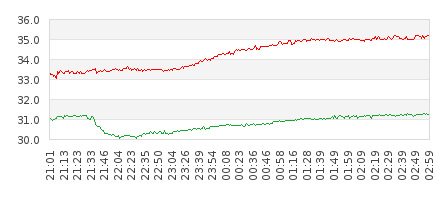

The situation repeats itself.As in test # 2, an increase in the temperature of the coolant by 4 degrees led to an increase in the temperature of the laminate by only 1 degree, while the screed warmed up immediately by 2. Now the difference between the surfaces has reached 4 degrees. And if the screed is already perceived as hot, then the laminate at a temperature of 31.2 degrees has finally acquired a "slightly warm" state again. But at what cost? 46 degrees in pipes.
The temperature of the floor surface, which with linoleum or tiles is reached at 38 degrees of the heat carrier, with a laminate on a 3 mm substrate is possible only at 46. 8 degrees higher! I mentioned above that there is no difference between expanded polystyrene and polyethylene foam. What is the difference with different thicknesses? 3 mm or 2 mm? Let's check.
Styling tips
According to feedback from users and craftsmen, laying laminate flooring on a warm water floor does not differ in its method from the usual one. After the question of which flooring to choose and all the materials have been purchased, you can proceed to the practical part. By the time of installation, the screed should already stand well and gain the required rigidity and strength. This can take about a month. It's worth the wait in order to lower the humidity level. Two weeks after pouring, the heating can be turned on. Every day you will need to monitor the temperature of the circulating fluid of the warm floor and raise it by 5 ° once a day. This will allow the entire surface to be heated evenly without temperature distortion. Two days before installation, the temperature of the warm floor must be set to the permissible maximum.
The laminate is brought to the installation room not one hour before the operation. It is advisable to do this in a day, or even more. This will enable the laminate to pick up the temperature of the warm floor and go through the process of deformation expansion. If this is not done in advance, then the problems will begin after installation, when everything is covered with cracks. It is advisable to keep the laminate boards closed for the first day, and then unpack them for another day. If the weather is not frosty, then you can unpack the laminate immediately.
The first step is to inspect the level of the surface, which was formed after laying the warm floor. Before installing the laminate on a warm floor after wet pouring, it is necessary to treat the area with a primer. This will hold the base together and eliminate the appearance of sand and dust on the surface. The area difference should not exceed 2 cm by 10 m. There is no need to use a waterproofing layer. The substrate is immediately laid. The latter for a warm floor must be used without a foil layer, otherwise the heat waves will not pass sufficiently.
The substrate is laid over the entire area with an overlap of 5 cm on the walls. The excess is cut off after the process is completed. Neighboring sheets are glued together using ordinary adhesive tape, metallized cannot be used. A gap of 1 cm must be made from each wall. It will allow the laminate to take the required shape without deformation when the temperature changes. You can mark this space for the laminate with wedges or pieces of wood. Subsequently, it will be covered with baseboards and will not be visible.
Everyone begins the installation of the laminate in the way that is most convenient for him. But professionals advise to do this from the far left corner of the door and move to the right and down. Thus, it turns out to lay the contour more efficiently. If in the first row the initial board was intact, then in the second row the laminate board must be shortened by 30–40 cm. This is necessary for bandaging the seams. For a more dense arrangement, each row of the laminate is tapped with a mallet through the block. An additional skill can be learned from the laminate installation video.
Source: bouw.ru
How to prepare underfloor heating for laminate
Arrangement of a water floor means pouring a screed into which pipes with hot water are mounted, due to which the floors are heated.Laying is done in several stages.


Before laying a warm floor, level the surface and clean it of debris
Related article: Making the facade of the house natural with marble chips
Work order:
- First you need to level the floor surface and clean it of dust and debris.
- Next, you need to put insulation and a reinforcing mesh.
- Then metal-plastic or polyethylene pipes are laid.
- The next step will be filling the cement-sand screed. For this, it is necessary to purchase special self-leveling construction mixtures.
- A week after pouring the screed, the "warm floor" system must be tested in action.
- The latter must be laid with a special soft shock-absorbing substrate. It can be penofol or extruded polystyrene.
- Lay the laminate on top.
The lamellas should not rest tightly against the walls, otherwise, when heated, they will increase in size and the floor will deform.
